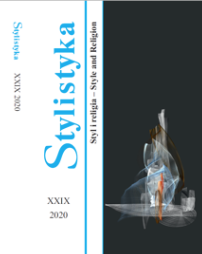Cysterska i jezuicka wersja Śląskich Litanii o św. Barbarze
The Cistercian and the Jesuit versions of Silesian Litanies to St Barbara
Author(s): Krystyna Kossakowska-JaroszSubject(s): Applied Linguistics
Published by: Uniwersytet Opolski
Keywords: St Barbara; prayer book; religious culture; Silesia Litania rudzka
Summary/Abstract: St Barbara is a patroness saint deeply ingrained in the culture of Upper Silesia. It was chiefly the 19th century that was deciding in this respect, since the process of linking the martyr-woman to the miners’ occupational group was concluded then. The miners’ community played a significant role in the socioeconomic and identityrelated character of the region. Consequently, the cult of St Barbara started to be grafted onto this land towards the end of the 17th century, mainly as a result of founding religious fraternities under the Saint’s vocation by monastic orders already based here. The process of accretion of fraternities aiming at religiousness and piety was connected with the plan of including them in the mission of re-catholicization of Europe, which followed the Council’s of Trident decision. Monks wrote into the systemic motifs of the epoch, since as regards the action which was being run, it was the Jesuits in particular who drew on the spirit of the Baroque to a large extent. The spirit itself propagated the idea of paltriness of the earthly world, which – in consequence – led to the fact that the necessity of man’s appropriate preparation for departing to the eternity came to acquire a great significance. St Barbara, who was one of the patron saints of a good death (beside St Joseph and St Anna) at that time, by patronizing fraternities inclined towards unceasing prayers for a good death, could naturally link those all-European trends with the Christian current of the right preparation of human beings for their death. Until the mid-18th century it was only single praying congregations dedicated to St Barbara that were established here. Still, even that proved sufficient to considerably strengthen the collective dimension of the Saint’s cult. The two editions of the Silesian Litanies to St Barbara date just from that time. The slightly older one comes from the prayer book Książeczka braterska sławnego i chwalebnego […] Bractwa Świętej Panienki i chwalebnej Krystusowej Męczennice Barborki […] [The fraternal book of the famous and respectable […] Fraternity of Saint Virgin and respectable Christ’s Martyr Borborka] published in Opava in 1740 for the religious congregation which was affiliated at the Cistercian abbey in Rudy near Racibórz, whereas the other one – from the booklet entitled Przeświętne Bractwo Barbary św., Panny i Męczenniczki Krystusowej, Patronki szczęśliwej śmierci […] [The glorious Fraternity of St Barbara Holly Virgin and Christ’s Martyr, the Patroness of a happy death], published by the Jesuits in Wrocław in 1747 for the Confraternity of Tarnowskie Góry. The prayer-books and the confraternities held the canonical status, since they were approved by the Holy See. They made the basis of sources to the local prayer books and song books in the 19th century. The litanies recorded in Polish old prints differ from one another, which resulted from the spirituality of the Orders that were patrons to the individual prayer books. The distribution of invocations is different and they raise different aspects of St Barbara’s cult, too. The text of the Litany inserted in the prayer book of Tarnowskie Góry accentuates the connection of the Patroness Saint with the worship for the Holy Sacrament. Hence the names given to her such as, among others, “Glory of the Holy Wood”, “the Ministress of the Heaven’s food”, “the Preventer of eternal hunger”, the Saint “treating out of the Goblet of Salvation”, “Patroness assisting on the frightful Doomsday”. On the other hand, in the monument of Ruda, St Barbara was associated with propagation of faith. Thus, she was addressed as, for instance, “Multiplier of God’s glory”, “a giver of praise to the Holiest Trinity”, “the Lover of faith in God”, “Destroyer of idolatry”, “the Mistress of Christ’s teachings invariably sticking with God”.
Journal: Stylistyka
- Issue Year: 2020
- Issue No: XXIX
- Page Range: 111-129
- Page Count: 19
- Language: Polish

